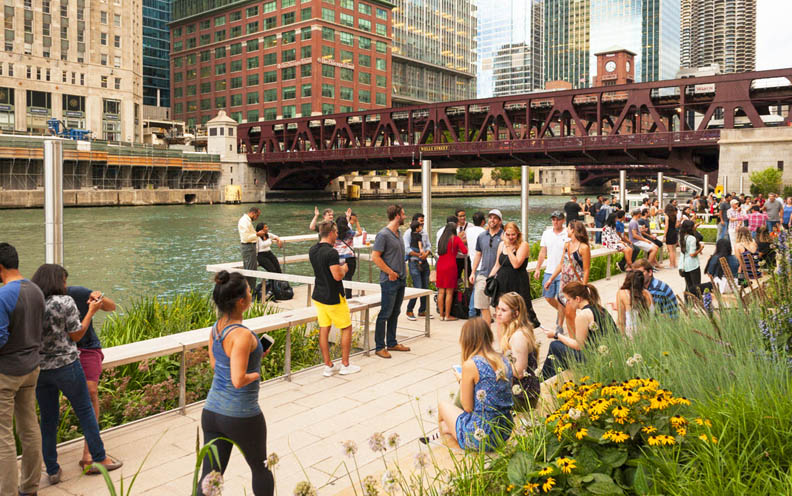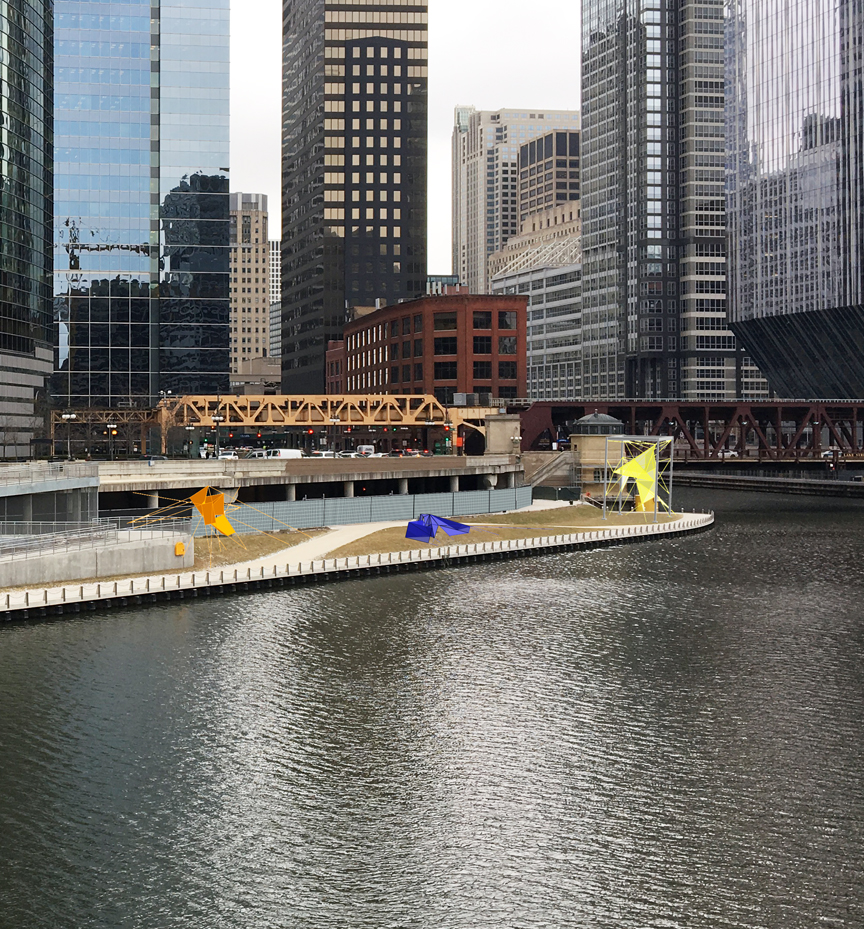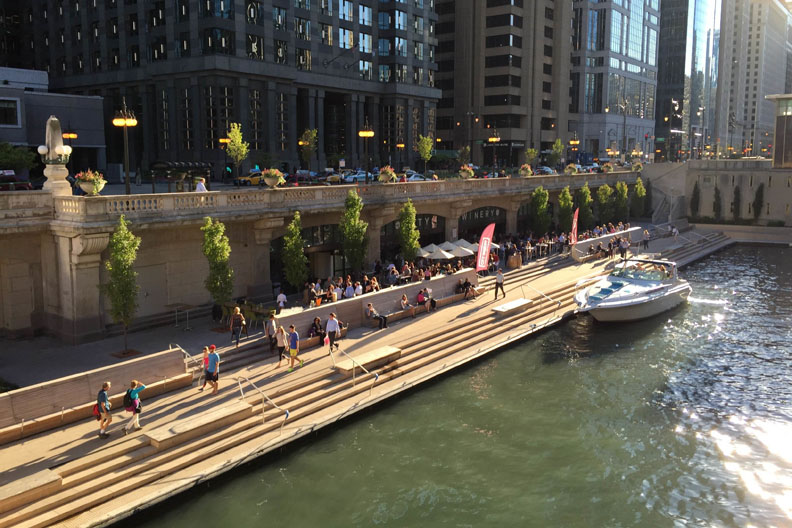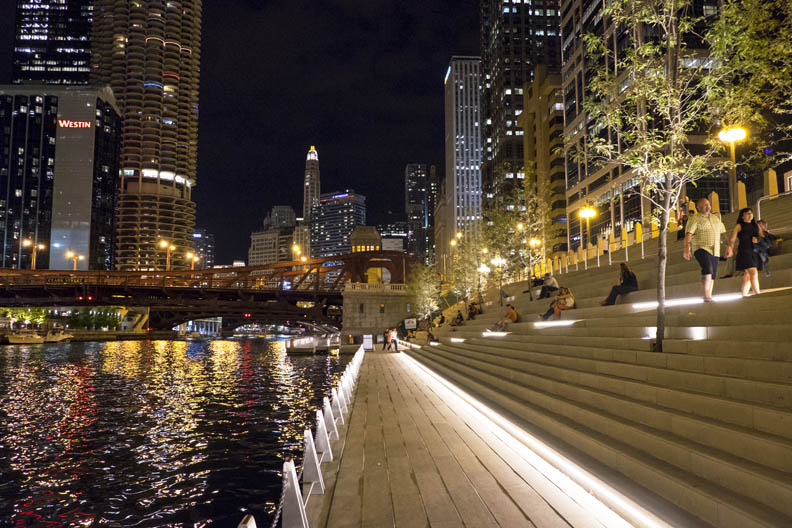The Chicago Riverwalk has Food, Music, Views & Great Art
Chicago is known by many names: The Windy City, the City of Big Shoulders, the Second City, Chi-Town, Chicagoland, Foodie Heaven.
OK, we paraphrased the last one, but everyone knows it’s true.
The Chicago Riverwalk area, along the Chicago River downtown, is an excellent example of where to see this ‘foodiness‘ in action.
FOODINESS
Dining and recreational opportunities abound along the banks of the Chicago River, including cafes, wine bars and craft brewing. Restaurants, many of which offer live musical entertainment, include Chicago BrewHouse, City Winery Chicago, Frost Gelato, Island Party Hut, The Northman Beer and Cider Garden, O’Briens and Tiny Tapp and Cafe.
RIVERWALK
The City of Chicago’s award-winning Chicago Riverwalk, a 1.25-mile promenade through the heart of downtown, has quickly become one of the city’s most popular destinations for art, music, dining and the enjoyment of natural habitats, beloved by Chicagoans and visitors alike. Replete with ample spaces for the appreciation of the city’s distinctive architecture, guests also encounter opportunities for boating, fishing, jogging and more as they traverse Chicago’s most beautiful waterway or bask in sunshine along the riverbank, savoring a tasty gelato or cool drink.
“The Chicago Riverwalk has helped transform the Chicago River into the city’s next great recreational frontier,” said Mayor Rahm Emanuel. “Today, the Chicago River brings people together, adds to our quality of life, and contributes to Chicago’s economic growth in a way that enhances, not endangers, our environment. It is great to see Chicagoans from every neighborhood, and people from every part of the world, enjoying the Riverwalk and experiencing the sights and sounds of Chicago.”

GARDEN IN A CITY
The Chicago Riverwalk is a prime example of the City’s official motto, “Urbs in Horto” (meaning “City in a Garden”), offering the serenity of nature amid the exciting vibrancy of an urban retail, business and arts hub. The six-block Riverwalk was officially completed in 2016 under the leadership and vision of Mayor Emanuel to transform the Chicago River into a recreational destination and weave the life of the River into the urban fabric of the city. The beautifully designed promenade features a series of distinct settings, each aesthetically cohesive yet unique in character. Beginning at the southwest corner of State Street and Wacker Drive, the Riverwalk moves southwest for six City blocks, divided into “rooms,” each partitioned by one of the City’s iconic movable bridges. These sections include:
- The Marina Plaza: restaurants and outdoor seating with views of vibrant life on the water, including passing barges, water taxis and sightseeing boats. (From State to Dearborn.)
The Cove: a restaurant, a kayak information center and docking for human-powered crafts, enabling physical connections to the water through recreation. (From Dearborn to Clark.) - The River Theater: a sculptural staircase linking Upper Wacker and the Riverwalk offering pedestrian connectivity to the water’s edge and seating, while trees provide greenery and shade. (From Clark to LaSalle.)
- The Water Plaza: a zero-depth water feature with playful fountains for children and families to engage with water at the River’s edge. (From LaSalle to Wells.)
- The Jetty: a series of piers and floating wetland gardens with interactive learning about the ecology of the river, including opportunities for fishing and identifying native plants. (From Wells to Franklin.)
- The Riverbank: an accessible walkway and new marine edge creating access to Lake Street and featuring a public lawn at the confluence. Providing an accessible route from lower to upper Wacker and Lake Street, it will be utilized for art installations in the future.

CHICAGO OUTSIDE ART ON THE RIVERWALK
Mayor Rahm Emanuel and the City of Chicago and the Department of Cultural Affairs and Special Events (DCASE) recently announced that a new site-specific art installation, Black Tiberinus by critically hailed Chicago-based artist Robert Burnier, is coming to the Chicago Riverwalk.
“Chicago is world-renowned both for its public art and the Chicago River, so it is fitting when the two come together,” Mayor Emanuel said. “It is a testament to the vitality of the riverfront that Chicago’s own Robert Burnier chose the Riverwalk for his latest work.”
The large-scale work, specifically commissioned by the City of Chicago for the Confluence section of the Chicago Riverwalk between Franklin Street and Lake Street, will feature three geometric structures made of steel, nylon mesh and rope. Responding to structural constraints imposed by the narrow strip of land that curves around the riverbend where Wacker Drive turns from west to south, Burnier’s suspended forms will hang over the lawn and be visible from Upper Wacker as well as the river level. With Black Tiberinus, the artist will construct an ephemeral monumental structure comprised of abstract forms and color. Burnier, who was recognized as a “Breakout Artist” by NewCity in 2016, combines mathematics, imagination and everyday materials to create inspiring forms that bear repeated viewings at various times and seasons.
The installation is expected to be completed later this summer and Black Tiberinus will remain on display through May 2019. With a title that references the Roman God of the River Tiber, the work joins the paintings by Candida Alvarez currently located east of Michigan Avenue and previous installations on the Riverwalk including Tony Tasset’s Deer and Scott Reeder’s Real Fake.
For more information about the Chicago Riverwalk and a complete schedule of events, visit chicagoriverwalk.us — or follow the conversation on social media using #ChiRiverwalk.




